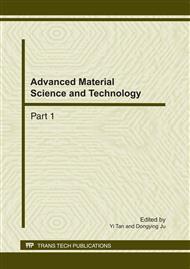p.303
p.307
p.311
p.317
p.321
p.325
p.329
p.333
p.337
The Comparison between the Borate Glass Ceramic Porous Scaffolds Preparing by the Sintering and Binding Method
Abstract:
A β-NaCaPO4 containing borate glass ceramic is prepared. Two kinds of porous scaffolds are constructed by sintering glass particles in the size of 300~400μm and binding glass particles in the size of 200~300μm using 5 wt% sodium silicate solution respectively. The reaction of the scaffolds in the SBF solution, the bioactivity and biodegradation of the scaffolds are characterized by weight loss analysis, XRD, and SEM. The same is done to the 45S5 scaffolds as comparison. The results show that the borate glass ceramic scaffolds have better biodegradation and bioactivity. The final weight loss of the sintering scaffolds and the binding scaffolds are 50.71% and 70.68% respectively, which indicates that the high temperature during the course of the sintering has great influence on the bioactivity of the borate glass ceramic scaffolds. The XRD indicates that the hydroxylapatite has formed on the both kinds of the scaffolds, and the hydroxylapatite on the binding scaffolds has higher degree of crystallinity. The residual glass phase of the glass ceramics contributes to a quick apatite formation on the scaffolds due to its high solubility in SBF solution, while the β-NaCaPO4 crystal phase leads to a slower apatite formation which guarantees an improved mechanical stability of the scaffold. This combined reaction mechanism enables the biodegradation rate of the scaffolds to match with the growth rate of tissues, which makes the scaffolds a good potential prospect in the field of tissue engineering.
Info:
Periodical:
Pages:
321-324
Citation:
Online since:
February 2011
Authors:
Keywords:
Price:
Сopyright:
© 2011 Trans Tech Publications Ltd. All Rights Reserved
Share:
Citation:


